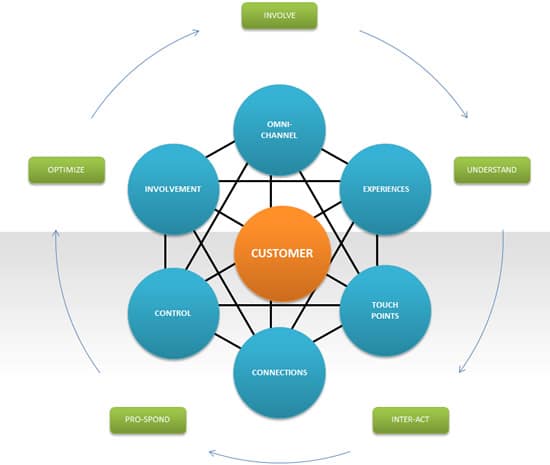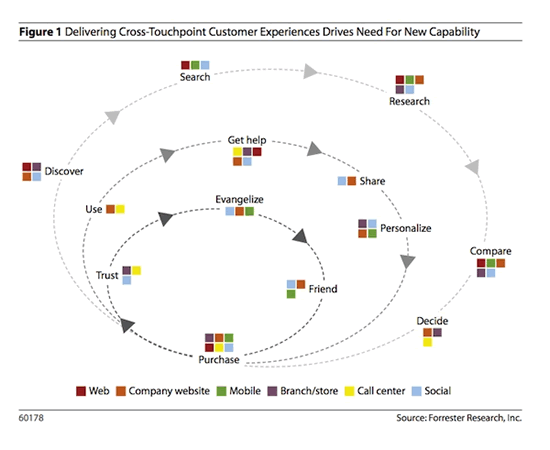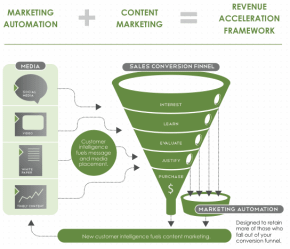Marketing automation: an in-depth introduction looking at benefits, success factors and evolutions.
Marketing automation originally referred to software developed to automate so-called repetitive tasks and was often seen as a subset of CRM (Customer Relationship Management) enabling marketing divisions to increase efficiency. There is a strong link between marketing automation, content marketing, content management and other platforms.
Marketing automation has shifted away from the pure automation aspect to an integrated marketing approach whereby automated workflows, pre-defined scenarios and various customer-driven triggers are set up in a connected and omnichannel way.
A ‘single’ customer view is essential as is a connected approach, also regarding other systems (CRM, content management, content marketing, social media tools,…), that often however start getting integrated in the offerings of some vendors.
That single customer view, however, is hard to achieve, and a true 360 degree customer view will never be possible as marketing automation and marketing technology expert David Raab explains in a soon-to-be-published interview. Yet, in order to get as close as possible to it, many organizations also use marketing automation platforms in combination with a customer data platform or CDP, a class of packaged software that is strongly on the rise, fits in that integrated data view, and is booming since 2016. Raab coined the term customer data platform in 2013 and today runs the CDP Institute.
Yet, back to the roots and essence of marketing automation before elaborating on why combining marketing automation and CDPs makes sense and, especially, when it does. While most marketing automation software is rooted in the CRM and/or email marketing industry, and email marketing de facto is still the main channel used for automated marketing workflows, an increasing number of channels and touchpoints is being added constantly.
Connecting the dots with marketing automation
Furthermore, the industry evolution towards more integrations and connections between marketing automation software, CRM, social listening platforms, etc. enabling organizations to focus on what really matters: their channel-agnostic – prospective – customer and their business goals.
This is seen in the consolidation in the marketing automation software market and the evolutions of the solutions that are mainly about more features to connect customers and different parts of the business while connecting departments (marketing, sales,…) and processes as well.
Another clear evolution is that towards an integration between content marketing, (web) content management, advanced marketing and business analytics, marketing resource management (MRM) and more.
Marketing automation software: differentiators
The main differences between various marketing automation software offerings concern:
- The target industry (small and medium business, large organizations, business-to-business, business-to-consumer, specific niche markets,…).
- The features: from automated email marketing workflows to full-fledged integrated marketing solutions (more below).
- The focus: while some marketing automation solutions are more about campaigns and automated workflows, other focus on internal processes, marketing resource management, etc.
- The degree of integration: marketing automation software doesn’t stand on its own. In order to close the loop between sales and marketing and/or customer service, for instance, an integration with CRM is essential.

Marketing automation software features
Typical marketing automation features include
- Connected and integrated marketing campaign management (often multichannel campaign management) whereby different channels play a role, depending on buyer personas, segments, individual touchpoints, flows and scenarios. Content and thus content marketing is essential here and in most other aspects of marketing automation.
- Lead/demand generation whereby workflows and content is developed to attract, identify, nurture, score and convert prospects. An important step is the hand-over of sales-ready leads. Other important features and elements are lead identification, online forms, lead scoring, etc.
- Lead management and customer experience management in some cases.
- Marketing intelligence and analytics. Marketing automation software offers a better view on analytics as it takes into account several channels, marketing investments and – most importantly – the customer as a whole instead of his “role” as an email subscriber or an anonymous website visitor.
- Marketing resource management (MRM) and marketing mix analysis. Depending on the marketing automation software, this can range from improving internal marketing collaboration, sharing of documents of collateral and synchronizing campaigns between various departments to full marketing ROI implementation.
- Advanced personalization, testing, segmentation and optimization features whereby insights from among others CRM and interactions across several channels, enable a more personal and more optimized customer experience and better marketing results. Potential features include A/B testing, Multi Variate Testing (MVT), dynamic content personalization, dynamic landing pages, etc.
- Advanced list management features whereby some marketing automation solutions are often ‘de facto’ also used as CRM tools since they offer so many features in this regard. However, virtually all marketing automation software also connects with different CRM systems as the list features are most often used for and by marketing whereas the CRM system is (also) used by sales (and other departments).
- Dashboards, reporting features, etc. that can be adapted depending on the role and needs of the user.
Most of all, however, the typical advanced marketing automation software:
- Takes into account the full customer lifecycle and provides triggered interactions providing value based on historical, demographic, transactional and increasingly real-time touchpoints, long after a lead has become a customer.
- Connects the dots between marketing, sales, customer service and other departments focusing on a single customer view in order to continuously improve customer experience and offer the content and messages or interactions needed to achieve business goals and optimize the customer relationship.
More features and typical aspects of marketing automation in the infographic from Marketo at the bottom of this page.
Marketing automation success factors
One of the misconceptions regarding marketing automation is that it is all about automating marketing and thus reducing the personal and human dimension.
This is not the case and depends on the ways marketing divisions use marketing automation. Most professional solutions offer advanced insight and analytics features, enabling a better customer view.
Furthermore, personalization features can improve the customer experience. And last but not least, professional marketing automation software and processes, involve offline and/or online interactions with customers whereby triggers and scenarios are included to direct prospects and customers to personal contact moments (e.g. being called by a customer service rep). Just like any other digital business and digital marketing process or software, the success of marketing automation implementations is not (just) a matter of technology or automation.
The success of a marketing automation implementation does not – primarily – depend on the selected marketing automation software either and – again – certainly is not about just “automating”.
If the automated workflows, interactions, offers, content, analytics, etc. don’t take the human and targeted/personalized/personal dimension into account marketing automation implementations lack important success factors.
Marketing automation success – among others – depends on:
- Ease-of-use and internal resources and learning curve. Marketing automation software is often underused because it’s too hard, the internal resources are absent and/or the needed skills are too “heavy” or absent.
- The efficiency of internal processes and relevance of designed flows. They should follow the customer before the brand’s priorities and both should be aligned.
- Content and relevant offers. Without timely and result-oriented content and offers, depending on the customer life cycle, marketing automation fails. The lack of relevant and timely content is a huge challenge for most marketers and marketing tactics, including content marketing and email marketing.
- Thinking and acting in a customer-centric way and not falling in the trap of automating for the sake of it. Marketing automation is not a holy grail. The business goals and the customer are what it’s all about. Without a customer-centric culture, supported by management, marketing automation often results in sheer auomation with little added value.
Marketing automation: towards a more connected customer experience
The attention for and growth of the marketing automation market is driven by several evolutions in the ways people inform themselves and buy.
The shift from selling to buying, along with the advent of several new digital channels, used by consumers and B2B buyers, keeps impacting the marketing automation industry and the adoption of marketing automation by organizations.
Marketing automation is not a holy grail and is still too often seen as a way to automate marketing. While the possibility to automate often repetitive tasks is essential, the human, connected and customer-centric dimension is essential.
In case of doubt: the customer is expected to be more in control than today. We’ve been moving to a more buyer-driven buying reality for years now and it’s a channel-agnostic phenomenon.
Marketing automation and the digital mix: it’s connected, deal with it
It’s time to integrate, connect the dots and – please – drop the ‘this channel trumps that channel’ approach. It’s time to look at the customer reality and business goals instead of at research and opinions to polarize discussions.
Marketing is connected and so are customers and their journeys. Deal with it. They’re not just connected with others (and, wake-up call, always have been), they’re also connected with our businesses across several touchpoints, far beyond the reach of the single campaign.
This does not mean campaigns are not important. People want to receive those promotional emails from brands they trust and buy from. Email works, basics work and new ways to interact with customers or improve the experiences across those interactions, shouldn’t be an excuse to ignore the essentials we have known since so long. It also doesn’t mean we shouldn’t use a proper channel mix, depending on what works best in any given context. But it’s not because someone claims “this or that” doesn’t work that it really doesn’t work. The truth is that many businesses don’t know yet in what context specific tactics work.
Look at YOUR business and your customers (and their customers and purposes). Prioritize and integrate around customer experiences and the proven methods in your business. But don’t let that withhold you to test and try new things, regardless of what research or opinions say. Beat the opinions and prove them wrong.
Moving to digital footprints beyond the first degree
All these evolutions also don’t mean that organizations will be passive respondents to customer signals and digital footprints.
Wake-up call number two: sales is not dead. It all depends and it remains essential to close the loop between marketing and sales. Yet, it is also time to close the loop with other divisions and with the customers and their networks themselves.
The input from interactions with customers is more important than ever. We need to move from being responsive to pro-sponsive, another key evolution we’ll see in the marketing automation space and even in marketing campaigns. We also need to move to a model whereby the overall customer life cycle is taken into account. The boundaries of the organization are blurring and so is the definition of the customer, even if we have to prioritize and remember those essentials.
That’s why traditional marketing analytics alone don’t cut it anymore and a single customer view needs to move beyond the simple lead management and funnel view. Connections and signals in social spheres do matter, whether you like it or not. And – again – they always have.
The touchpoint challenge in marketing automation and definition of timing
The adagio in marketing automation, content marketing, inbound marketing, content management and even email marketing is ‘providing the right information to the right people at the right time across the right channels’.
Overlapping umbrella terms that in practice mainly focus on the message dimension, often even when it concerns timing (“What is the best time to xyz?”).
However, the best timing is becoming more touchpoint-oriented and triggered, and less defined by general best practices. It is already the case in marketing automation but we still have a long way to go in order to shift to the personal touchpoint perspective. Again: this doesn’t mean that today’s approaches will disappear. Marketing is not black and white.
Optimizing the experiences of people and moving from automation on the interaction level to a personalized and pro-sponsive optimization on the individual touchpoint level is, according to me, the main challenge in marketing automation for the future, as well as the integration of business processes and the business as such within its’ ecosystem beyond marketing.
Providing the right information (content, offers,…) to the right people across the right channels beyond the right time and the traditional funnel: from right-time to customer- and touchpoint-time.

Conduct campaigns, prioritize and focus on the basics of conversion, optimization and customer experiences but at the same time don’t ignore the voice of the customer, the clear shifts and the channel-agnostic reality with more stakeholders than ever before because you want to stick to a channel-centric mentality. In the end that’s where social CRM – in the true sense of the word – comes in.
More resources, evolutions and tips regarding marketing automation
Marketing automation and content marketing
Without a solid content marketing strategy to engage prospects across different touchpoints and stages of their buyer’s journey, marketing automation fails.
Creating enough content at a reasonable cost is one of the top challenges to marketing automation, according to many marketers. Others include data quality and integration, poor marketing processes, lack of skilled staff and organizational culture.
If you don’t build your marketing automation processes around the customer, just as you would do in content marketing, marketing automation is doomed to fail and it becomes even harder to close the loop between marketing, sales and customer value. Vendors have a responsibility as do marketing automation users and agencies. Change management is a must and it’s a well-known fact many organizations buy expensive marketing automation solutions while only using a limited percentage of available features and not even in the best way possible. No marketing automation without a realistic approach, a customer-centric strategy (based on touchpoints, journeys, etc.) and certainly not without a content marketing strategy.
Understanding the customer life cycle and calculating CLV
While marketing automation often looks at generating demand and new revenues by a “right time, right message, right touchpoint” approach, as we know it in content marketing and content management as well, it’s essential to also look at engagement with existing customers of course.
After all, the total customer life cycle and Customer Lifetime Value (CLV) are essential. In this regarding marketing automation platforms are evolving and also facing competition from new vendors focusing more on customer engagement and experiences across the customer life cycle. Several vendors in the content management space have also been evolving from systems of records to systems of engagement. Marketing automation is part of an increasingly broader ecosystem and context where the customer and customer lifetime value are key. An introduction to the customer life cyle and models to calculate the customer lifetime value (CLV).
Four multi-channel and touchpoint marketing models
Touchpoint-based marketing and customer experience models become increasingly important as the customer journey changes but most of all as the focus should not be on the channels and campaigns as is often the case in marketing automation but (also) on the longer-term (smart marketers move away from short-termism) and most of all the customer experiences in a highly connected and integrated digital reality. Find a few touchpoint models and read Why touchpoint marketing is important.
Marketing automation: infographic overview



